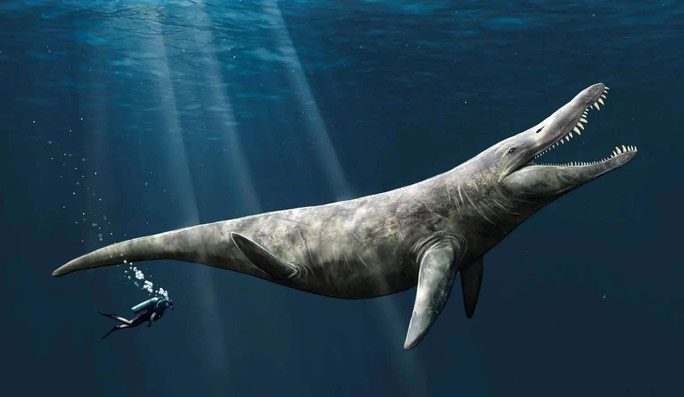A local museum in England has inadvertently… stored a unique treasure for many years without realizing it: The strangest sea monster of the Jurassic period, fierce as a T. rex but larger.
According to SciTech Daily, this astonishing discovery originated from paleontologist Megan Jacobs of the University of Portsmouth (UK), who photographed a plesiosaur skeleton at the Abingdon Town Hall Museum in Oxfordshire. She noticed an enormous, unusual vertebra that did not belong to the plesiosaur.
Ms. Jacobs inquired with the curator and was delighted to learn that there were three similar vertebrae stored in the museum’s collection.

Graphic depicting the “ocean T. rex” with a diver alongside for size comparison – (Image: UNIVERSITY OF PORTSMOUTH)
The specimens were meticulously studied by a team from the University of Portsmouth, revealing that the museum held rare remnants of a legendary sea monster without being aware of it!
It is Liopleurodon, a bizarre creature from the group of short-necked plesiosaurs, long known to paleontologists but almost as a “ghost.”
Professor David Martill from the School of Environment, Geography, and Geosciences at the University of Portsmouth, the lead author of the study who has been researching Liopleurodon since the 1990s, stated that in past decades, Liopleurodon was estimated to grow up to 25 meters long.
However, this was merely speculation, as no sufficiently large bones have been found from this Jurassic monster. It was known to exist, a new, distinct, and dangerous species.
The fossils preserved by the museum in Oxfordshire unveiled the mystery, as they are fully intact vertebrae, enough for scientists to make it “materialize” again.
This creature is believed to have lived approximately 142-152 million years ago, belonging to a rare group of short-necked plesiosaurs, different from the long-necked appearance of other species in the same group.
It measures at least 14.4 meters long, rather than the previously estimated 25 meters. Nevertheless, it remains incredibly dangerous.
“They have massive skulls with protruding teeth, enormous like daggers – comparable to T. rex, if not larger, and certainly stronger,” Professor Martill described.
It is also larger than most sea monsters and land beasts of its time, as well as twice the size of modern killer whales. This suggests it could very well be an ocean version of T. rex, a sea monster “tyrant.”
Professor Martill added: “They were at the top of the food chain in the ocean and likely preyed on plesiosaurs, other short-necked reptiles, and possibly even marine crocodiles, by biting their prey in half and tearing it into pieces.”
This description aligns with several other paleontological findings, including plesiosaurs that were horrifically bitten before fossilization, with monstrous bite marks found on their bones, previously displayed in various collections in England.
This specimen, dubbed the “ocean T. rex,” was excavated earlier at Warren Farm in the Thames Valley, Oxfordshire, from the Kimmeridge Clay formation dated to 152 million years old.
The research has just been published in the scientific journal The Proceedings of the Geologist’s Association.


















































